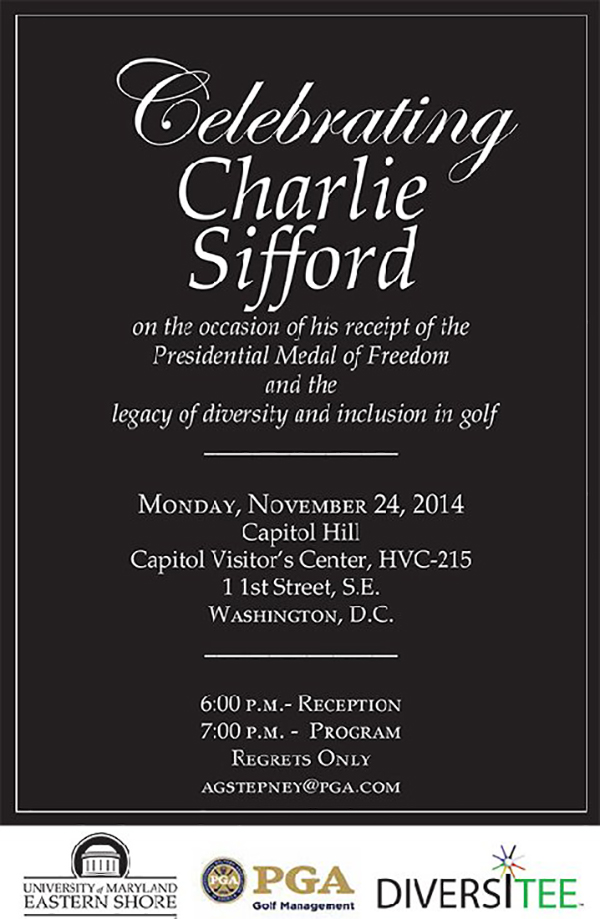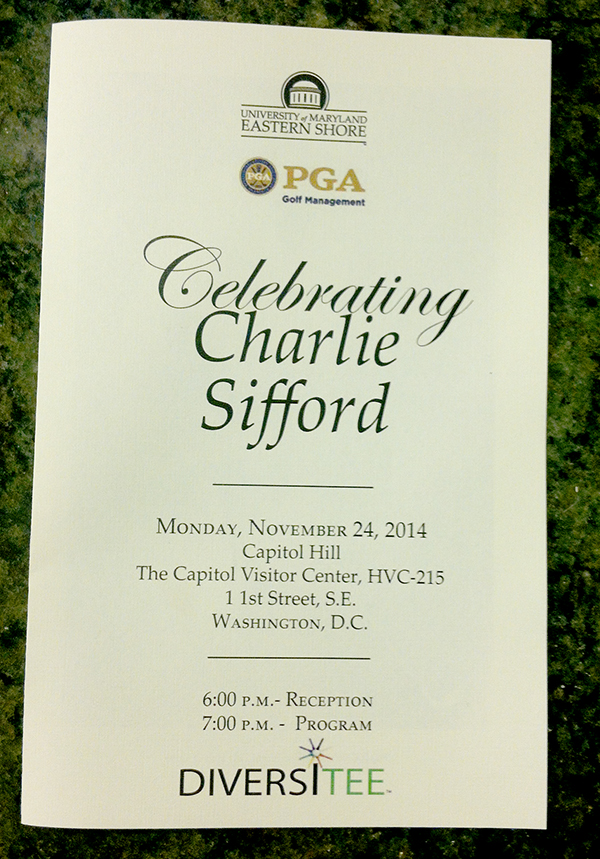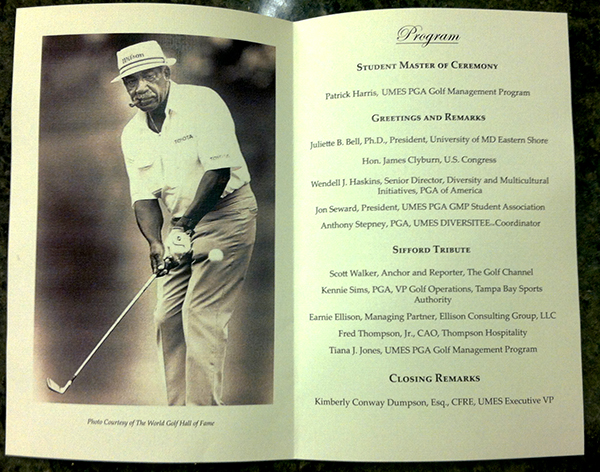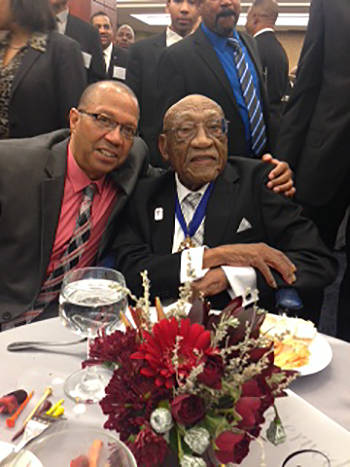
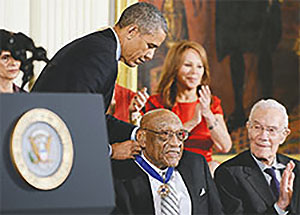 Those were the words from President Barack Obama, as he delivered the introductory speech for Dr. Charlie Sifford. Moments later he graciously placed the Presidential Medal of Freedom around the neck of this legend and shook his hand. The ceremony took place at the White House on Monday afternoon, November 24, 2014.
Those were the words from President Barack Obama, as he delivered the introductory speech for Dr. Charlie Sifford. Moments later he graciously placed the Presidential Medal of Freedom around the neck of this legend and shook his hand. The ceremony took place at the White House on Monday afternoon, November 24, 2014.
Photo left: Michael Cooper, Ph.D. shares a moment with Presidential Medal of Freedom recipient Charlie Sifford.
Immediately following the ceremony I attended an “after party” down the street from the White House on Capitol Hill. The after party was hosted by the University of Maryland Eastern Shore (UMES), the lone historically black college/university sanctioned with the professional golf management (PGM) curriculum. Approximately 150 people participated, and there were loud cheers and applause when the Sifford family arrived.
A ROOM FILLED WITH CELEBRATION
Dr. Juliette Bell, President of UMES, welcomed all to the festive occasion. The Honorable James E. Clyburn spoke next, and explained his passion and commitment to advocating for Dr. Sifford at the highest level. I have no doubt that the occasion would not have happened without his leadership.
It was also apparent that the award would not have happened without the help of the PGA of America. Wendell Haskins, Senior Director of Diversity for the PGA contributed mightily, as did Earnie Ellison, Renee Powell, and Susan Wasser with the USGA. All were in attendance. Other notables included Scott Walker with the Golf Channel, legendary black golfer James Black, Rose Harper, Debert Cook, Kennie Sims, and Anthony Stepney, both PGA members.
UMES took the opportunity to showcase and introduce a collection of bright, young talented students currently enrolled in their PGM program. We learned that approximately 20 schools carry the PGM program, and UMES has more minority students participating than all the other schools combined. Led by Kimberly Dumpson, with help from Stepney, the school and program should be a major contributor to the golf industry going forward.
Let me get back to Charlie Sifford. I grew up in Chicago, IL. Southside! I was fortunate to get exposed to golf by my father. At that time, black golfers on the southside of Chicago either played Jackson Park GC or Pipe O’ Peace. I played both, but Pipe O’ Peace GC was home. Bobby Milton was the head pro. Mr. Milton was a former Harlem Globetrotter, and he had an incredible network of friends, dignitaries, and celebrities.
Bobby Milton had a habit of showing me off to others. For example, he once arranged a nine-hole match with me, him, Althea Gibson and Billy Eckstine. Another time, a nine-hole exhibition with me and Lee Elder. Years later, as I grew older, I realized it was out of pride. At that time, my fundamentals were solid, and I could score in the mid 70’s on a regular basis. I was a good student in school, too, so in my community, I represented hope for the future.
Our golf course was also known throughout America, and most black golfers would gravitate to Pipe O’ Peace whenever they traveled through Chicago. One could always find a game there, a friendly wager, or simply enjoy the camaraderie and entertainment that followed black golf in that era. It was there that I first met Charlie Sifford.
I probably was around 15 years old and serious about my golf game. Dad exposed me to the best teachers we could find. Cliff Brown, a former PGA Tour player, was my mentor and main instructor. Our golf course did not have a driving range, but we had an area alongside hole number 14 that we used to shag balls. One afternoon as I hit balls I turned to see Bobby Milton and Charlie Sifford approaching. I knew Mr. Sifford from television. I also had heard his life story hundreds of times from Cliff and other adults.
We didn’t have Golf Channel back then, but golf was still televised on most weekends. I admired golf champions like Nicklaus, Palmer, Player, etc, but my real heroes were Cliff, Pete Brown, the Thorpe brothers, James Black, and a host of others who came through Pipe O’ Peace each summer. In short, my heroes and role models were the golfers of color who I had close, personal relationships with. Charlie Sifford was in a class by himself, though. His place was higher on a throne than anyone. His legend seemed bigger than life, to me, and I’d never met him…until that day.
I still recall the feeling of anxiety and sudden lump in my throat as they approached. Bobby said: “this is the young man I’ve been telling you about.” Charlie simply nodded in a way that suggested I keep hitting balls. I hit the first shot and got absolutely no response. Hit ball number two and got a grunt. No words, just a grunt. After ball number three Mr. Sifford nodded again, and said: “Dang junior, looks like you know what you’re doing. Keep it up.” With that, he reached over, shook my hand, and he and Bobby Milton began to walk away. I was in awe! The late Maya Angelou once said: “They may forget what you said, but they will never forget how you made them feel.” Well, Charlie Sifford made me feel like a champion that day, and I’ll never forget it!
While the years have passed, my admiration for Charlie Sifford has only gotten stronger. I co-hosted a book signing featuring him in 1992, when he first released his autobiography, Just Let Me Play. I traveled to St. Augustine, FL in 2004 when he was inducted into the World Golf Hall of Fame. Wouldn’t have missed that for anything! In 2010, I had the privilege to speak in Charlotte, NC, at the grand opening of Charlie Sifford Golf Course. And now, on Monday, November 24, 2014, I was honored to see his smiling face after being presented with the Presidential Medal of Freedom. Charlie Sifford continues to be my hero. He has touched my life for over 40 years, and his legend lives forever in American history.
ABOUT MICHAEL COOPER, PH.D.
Dr. Michael W. Cooper is the Campus Director for Springfield College-Tampa Bay campus. He is also the former Director of Diversity for the World Golf Foundation and Southeast Regional Director for The First Tee. Contact him at mcooper2@springfieldcollege.edu.


